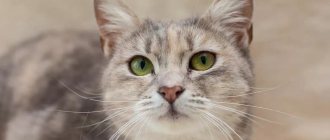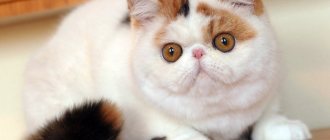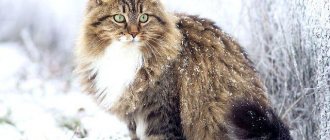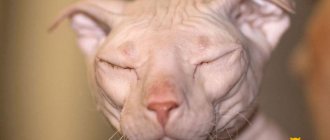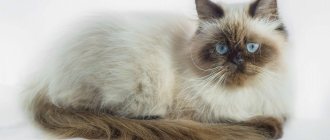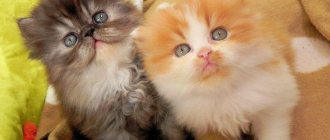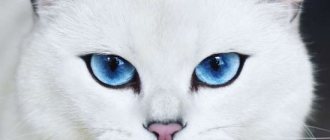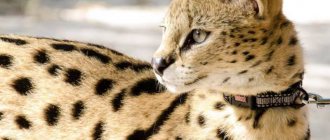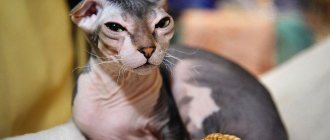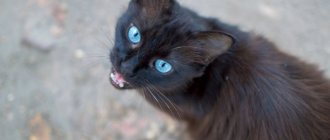For quite some time now, a stereotype has developed among breeders and ordinary people that Siamese cats are by nature very angry and unsociable. This is far from true. The Siamese are very touchy and show aggression only towards those who once offended them.
These elegant beauties have the best memory of all cat breeds. Siamese are also responsible for unacceptable attitude towards people. But if the cat understands that he is loved and punished only for his deeds, then he will become the kindest and most gentle friend.
History of the breed
The first description of cats of this species is given in the treatise Tamra Maew - “The Book of Poems about the Cat”. Initially, privately owning the “Siam Moon Diamond” was a privilege for the royal family and nobles. After the death of the owner, the animals became temple relics, living off the rich offerings of the deceased's family. There was a ban on taking them out of the country under penalty of death.
Watch a video about the Siamese cat on our Youtube channel Mister Cat:
Geneticists believe that this species originated from the wild Bengal cat, since the gestation period of the Siamese female is longer than that of other breeds and is 68 days - the same as that of their ancestor. The Siamese appears in many legends and myths about the origin of the cat.
The breed came to Europe as a gift from the royal family to the English ambassador. This unusual animal was first presented at a London exhibition in 1872. The Siamese became a royal property here too. Queen Victoria bestowed them on nobles only for the greatest merits.
The first feline standard for the Siamese cat was compiled by Harrison Weyer, squint and knots on the tail were included in the description as advantages. Only by 1904 the standard was modified and refined. The requirements for the exterior of the animal have changed. A longer and more flexible body, larger ear size, no squint, no tail defects - this is the type of Siamese that leads in today's exhibitions.
In the sixties of the twentieth century, the breed was brought to the United States of America, where its appearance caused a real stir. Breeders purchased breeding animals for fabulous sums.
The last European standard for the Siamese cat was adopted in 1966, and the American one in 1991. The requirements for the appearance of the animal in these two systems differ slightly from each other. The first Siamese appeared in Russia at the end of the twentieth century.
Interesting fact. Siamese cats are fluffy, i.e. They are not long-haired. Usually they mean Balinese or Himalayans (which are more like long-haired Thais).
“Fluffy Siamese cat” or Balinese breed
Himalayan cat
Javanese
In the late 1970s, Maureen Davis began breeding Siamese-colored Balinese dogs, but in different colors. This is how the Javanese cat breed came about.
Javanese are very active and require a lot of attention, which they achieve by any means. They are distinguished by a strong attachment to their owners. The graceful, fragile appearance of these cats is surprisingly combined with their strength and strong muscles, which are hidden under a thin, silky coat. In everyday life they are hardy and unpretentious, they become very attached to children who know how to handle this independent creature. They mostly get along well with other pets; much in this situation depends on the character of their neighbor.
Characteristics and breed standard
The felinological association TICA gives the following description of the Siamese cat breed:
- Head. Elongated wedge-shaped with close-fitting fur and ears. A slight presence of “cheeks” is allowed only in adult purebred breeding males.
- Eyes. Medium size and eastern cut. They are spaced quite narrowly - the distance between them is equal to the length of one eye. The color is bright from blue to sapphire - all shades of blue. Green tones are not allowed.
- Ears. Quite large, located at an angle and extend beyond the cheekbones. The fit as wide and low as possible is considered a plus.
- Neck. Long, slender, graceful, but muscular.
- Body. Long and graceful, yet strong and muscular without being massive. Equal width along the entire length.
- Paws. The skeleton is light. Long and thin with narrow and elongated pads. Muscular. The rear ones are higher than the front ones.
- Tail. Thin throughout its considerable length. The tip is tapered and pointed.
- Wool. Short, close to the body, shiny.
- Colors. Color point is required for any color. Points are located on the face (“mask”), ears, paws, and tail.
The number of acceptable colors is twelve.
- Weight. The male is larger than the female. Average weight is from three to five kilograms.
- Only intrabreed matings are allowed.
- Flaws. Spots darker than the main background on the chest and abdomen. Darkening the main background. Poor contrast.
Disqualification:
- No color point.
- Any eye color other than all shades of blue.
- White markings and white toes.
- Strabismus.
- Kinks and knots on the tail..
- Malocclusion.
- Polydactyly.
- Aggressive behavior.
Mekong Bobtail
This cat, according to legend, guarded young maidens in the ancient monasteries of Siam. They put their jewelry on the cat's tail. When there were too many of them, the animal's tail broke. That's why Bobtails have a short tail.
These cats have the character of a dog. They can carry objects in their teeth (and with pleasure), perform the “fetch” command, and walk on a leash. Also, these cats become attached only to the owner, and not to the house.
Mekongs are talkative, but do not like to show their emotions. The common feature with the Siamese cat is color.
Colors
All Siamese kittens are born completely white, since the ambient temperature in the womb is high and uniform. With age, points begin to darken, which is associated with different temperature conditions in individual parts of the body. Dark markings - points - are located where it is lower - on the face, ears, paws and tail. The light background is usually formed by the albinism gene.
In total, modern felinology has identified twelve acceptable colors of the Siamese:
- Sial point. The main background is creamy, perhaps to rich brown. The points are anthracite black.
- Blue point. Light, fawn-gray background, blue back, points of a more saturated blue to blue-smoky. The nose and fingers are blue-gray, almost ashen.
- Chocolate point. The background is the color of baked milk or ivory, the points are coffee with milk. The paw pads and nose are the same color.
- Lilac Point. The main background is pale cream, yellowish, points with a pinkish tint. Fingers and nose are lilac.
- Red point. The main background is white to apricot, the points are bright red-gold. The nose and paw pads are pink.
- Cream point. The background is white, the points are cream.
- Caramel point. The background is caramel, the points are a darker shade of the same color.
- Cynamon Point. The body is ivory, the points are brown. The nose is brown and the paw pads are pink to brown.
- Fawn point. Pale light cream background, points color beige. The nose and paw pads are light pink.
- Torty point. Points with tortoiseshell pattern, all color combinations.
- Tabby point. Stripes on points.
- Tabby-torty-point. Spots and stripes on points.
There are four main colors in the classification: sial, blue, chocolate and lilac points.
Mister Cat warns: differences between Siamese and Thai cats
A common misconception is that Thai and Siamese cats are considered the same breed. Like, it's all the same thing. And how can there be any doubt when Thailand was called Siam until the mid-20th century. However, despite all the common features, namely similar color, the same country of origin, as well as a common breed group (Siamo-Oriental), these are different breeds.
By the way, both cats have the same ancestor; he appeared in Thailand in the 14th century. As a result of long selection, today we have two different breeds. Moreover, it is the Thai cat that has the old-type exterior of the Siamese, i.e. at the end of the Middle Ages, this is exactly what this cat looked like, and the modern Siamese did not exist at all.
On the left is a Siamese cat, on the right is a Thai cat
The body and head of the Thai are more rounded and less refined, the ears are not so widely spaced, and the eyes are rather round in shape.
Read more in a separate article about Thai cats on our portal.
Thai kittens
There are also differences in character - there is no Siamese arrogance, these are softer and more obedient pets, selfless and devoted, but just as energetic and active.
Breeds developed using the Siamese cat
The Siamese cat fascinates with its elegance, unusual characteristic color-point color and sapphire eyes. Breeders of many cat lines are tempted to introduce these peculiar traits into their pets. As a result of breeding work based on the Siamese, the following breeds appeared:
- Australian;
- Burmese - short-haired Siamese without points;
- Balinese - Siamese and Angora combined with a long-haired Siamese;
- Himalayan (Khmer) - Siamese and Persian, fluffy mestizo with color-point color;
- jungala;
- California Speckled - Abyssinian, Siamese, British and American Shorthair, Manke, Persian, African and Asian street cats;
- Ocicat - Abyssinian and Siamese;
- snow-shu - Thai type in white socks;
- Neva Masquerade - Siamese and Siberian;
- Tonkinese - Samskaya and Burmese;
- Javanese - Siamese and Abyssinian.
Balinese
So, the Balinese cat breed is similar to the Siamese. Let's start the description of this breed with the appearance of the representative. This slender and miniature, graceful cat. It has long legs, an elongated body, large ears, and is fluffier than representatives of the Siamese breed.
These cats love to chat and purr. They are loyal to their masters, and much stronger than any others.
This affectionate cat breed, similar to the Siamese, gets along with anyone.
Therefore, if you want to buy a Siamese, but his character is intimidating, choose a Balinese. These cats are much more docile, and they are not at all vindictive.
The origin of this breed is directly related to the Siamese. In the 50s of the last century, breeders accidentally bred a breed of cats similar to the Siamese. Long-haired kittens obtained from breeding representatives of the species initially surprised scientists and were therefore discarded. But then American breeders decided to conduct an experiment on long-haired animals. As a result, they got Balinese cats. They have attracted many animal lovers.
Features of the Siamese cat's temperament
The Siamese is an eternal child with an endless supply of energy. Playful, cheerful and endlessly devoted to the owner and all household members. If he believes that someone close to him is in danger of trouble, a faithful and fearless dog will rush to his defense. The peculiarities of temperament make the pet look like a rare symbiosis of a cat, a monkey and a dog.
These animals are distinguished by their “talkativeness”; the timbre of their voice is very unique and does not resemble the meow of ordinary cats.
There is often an opinion about the evil and vindictive nature of the Siamese, their aggressiveness. If pets are raised correctly from an early age, then no problems arise with their maintenance. Some irritability is inherent in those representatives of the breed who have tail defects. In this case, the integrity of the spine is compromised, pain and, as a consequence, imbalance are possible.
Also read the article about evil cat breeds. Who is to blame for their aggression?
It is necessary to remember the extraordinary self-sufficiency and high pride of these pets. Loud yelling or physical punishment can be perceived as severe insult. You should never raise your voice to Siamese, much less hit them. These animals require polite, patient and attentive treatment. Mutual respect and love is the only form of peaceful coexistence between Siamese cats and people.
Burmese
Burmese cats were bred by French breeders in 1925. Outwardly, they resemble soft toys: fluffy with big blue eyes.
A distinctive feature of the Burmese are the “gloves” on their paws. She differs from the Siamese in her calm disposition, she can easily find something to do on her own, has a calm character and is moderately energetic. Representatives of this breed are good at feeling the mood of their owner: they can calm a choleric person or lift the mood of a melancholic person.
Care, education and maintenance
These animals do not cause the owner any problems with care. The short, shiny coat requires virtually no washing or combing. If necessary, these procedures are carried out quickly and carefully, respectfully towards the pet.
If the Siamese's claws cause concern, once a week you should trim them with special scissors, carefully - only the very tip at a right angle.
Siamese are very smart and they have no problems with education, but it is necessary to accustom the kitten to the tray and scratching post from an early age.
Health and nutrition
Eating is also not a problem. It is advisable to switch your pet to super-premium quality dry food after breastfeeding. They contain all the necessary vitamins, micro- and macroelements.
If natural nutrition is organized, then it must be properly balanced and always with the addition of special preparations containing taurine and vitamins.
Two hereditary defects plague this breed—squint and knots or kinks in the tail. They are caused by the same gene that provides bright sapphire eye color. Calcivirosis is also a disease that this breed is prone to. It is necessary to prevent your pet from hypothermia and vaccinate it on time. Sometimes there is a defect in the development of the middle ear - it manifests itself in impaired coordination of movement.
Due to their labile temperament, they are prone to psychogenic diseases, which often lead to alopecia, since the animal is constantly licking itself.
For timely detection and prevention of diseases it is necessary:
- Deworm your pet regularly, at least once every three months.
- Promptly treat for external parasites.
- Vaccinate against rabies and viral infections annually.
- Periodically visit a veterinarian to identify hereditary diseases and prevent them.
The average lifespan of a Siamese is fifteen years.
Interesting Facts
- The famous point color, which gives the Siamese a special originality, is considered a manifestation of acromelanism. This is a genetically determined pigmentation that appears only in certain areas of the body. This is due to the biological feature of the limbs, ears and tail of living creatures to be less supplied with blood, and, consequently, to heat up. The color of the Siamese's coat depends on the temperature, and therefore when it drops, its shades become darker.
- There is an opinion that Siamese are angry, aggressive and morbidly vindictive. To some extent this is true. But still, these qualities are not characteristics of a pure breed. And the reason for such rumors that spread in Russia was the haphazard crossing of Siamese cats with outbred cats and unsuitable relatives, which took place at the dawn of their breeding in our country.
- Siamese tails often look broken at the ends. Some attribute this to the characteristics of the breed, others to imperfections in selection and even genetic deviations. However, the ancient inhabitants of Siam had a different opinion. There was a beautiful legend that a certain princess of this country, wanting to swim, was forced to take off her jewelry every time. And to keep them safe, she entrusted them to her beloved cat, stringing the treasures on her long tail and tying it in a knot. This is why the descendants of this pussy sometimes end up with kinks at the ends of their tails.
- The remarkable color of Siamese cats is a consequence of albinism. And it turns out that although this is a deviation, it is extremely remarkable. But the color of the eyes of such pussies is also considered a painful consequence of the lack of melanin, because this is also a sign of albinos. This congenital disorder also affects a cat's vision. It is assumed that Siamese do not see objects in volume, which is why they often suffer from strabismus. It appears from the cat’s desire, straining its eye muscles, to compensate for the shortcomings of its vision.
- But still, Siamese pussies are very cute. Therefore, it is not surprising that they became the favorites of famous actors and actresses such as Faina Ranevskaya, Armen Dzhigarkhanyan, Glenda Farrell, Kim Novak, James Dean, Vivien Leigh, Olivia de Haviland. According to some reports, in the main residence of American presidents, the so-called Oval Office, in recent years at least three Siamese pussies have found refuge under the care of high-ranking owners.
Choosing a kitten and cost
The cost of a kitten varies from 200 to 800 dollars, depending on the purpose of the purchase. A pet-class kitten is cheaper, but has no pedigree and can only be a pet. For breeding work and an exhibition career, it is necessary to choose a blue-eyed baby with a good pedigree and excellent health.
The price of individual pedigree cats can exceed a thousand dollars.
All kittens from the nursery must be accompanied by veterinary passports with notes from the state veterinary clinic on vaccination against rabies and all known feline infections.
1111
